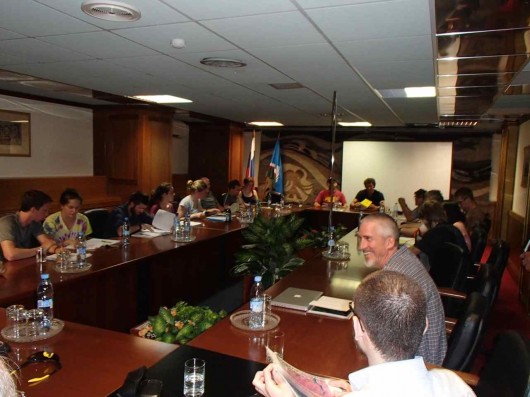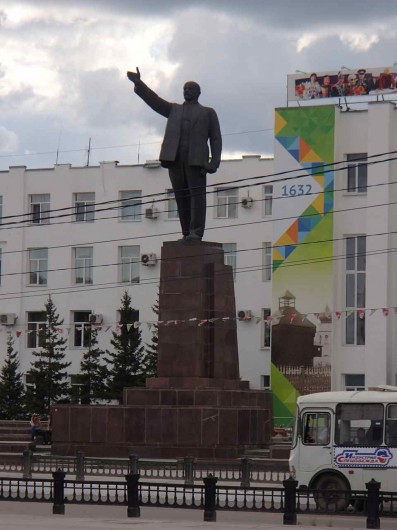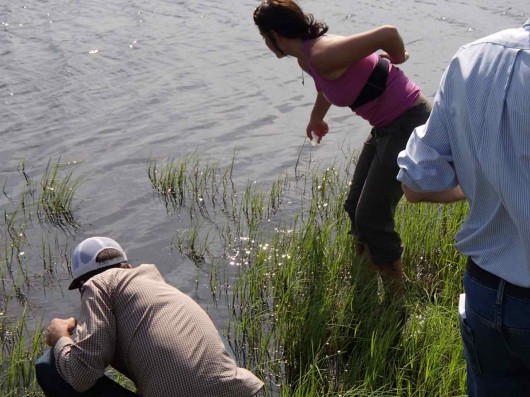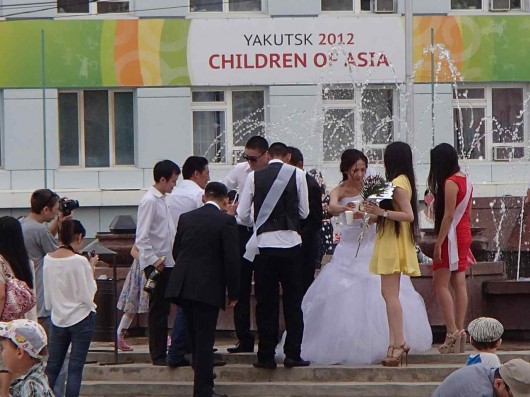(This post is by Mark Paricio, a PolarTREC teacher accompanying the Polaris Project this year.
To read all of Mark’s posts, go to: http://www.polartrec.com/expeditions/siberian-arctic-systems-study )
Although we had hoped to be in Cherskiy already, our unexpected extra day in Yakutsk was remarkable. Because our Polaris Project group was quite numerous (over 30), we were split into two different hotels. Most of the group stayed in a nice hotel near the flood plane of the Lena River that passes next to Yakutsk. I was in a small group of seven who were placed in a smaller hotel that was a 20-minute walk away. This gave the seven of us the opportunity to walk through Yakutsk’s central area several times during the day, which allowed a new perspective of the people of Yakutsk.
A Statue Points the Way
Perhaps the first impression of a Russian city comes from the obligatory statue of Lenin, pointing north to the future. As it turned out, that statue did point exactly the direction the seven of us needed to go to get from our hotel to the main hotel.
When we arrived at the main hotel and joined the other members of the Polaris Project, we took advantage of the opportunity to walk out and make observations of the flood plane of the Lena River, one of the largest Arctic rivers in the world, and a definite favorite of Polaris Project PI, Dr. Max Holmes. As we walked, Max used the opportunity to construct an educational dialogue with the undergraduate students (and me!) about how to decipher the clues surrounding the river.
From the debris field among the willows, we were able to see the high point of the spring flood stage of the river. It was startling how far away from the main stream of the river the debris had been deposited among the willows and grasses on this vast flood plane! It was not even possible to see the main stream of the river from the high point!
Additionally, Max talked about ways of potentially estimating the dissolved organic material in one of the side streams we encountered by observing its color, its flow, and its distance from the main stream of the river. Listening to the thought processes of Max and the other Polaris Project members during this outdoor class showed how these scientist and science students use background knowledge and observational skills to piece together the puzzles they encounter. The culminating part of the lesson was that often we are wrong with our estimations and the model we develop to understand a region or problem. That is why we take careful measurements – to see what is actually going on in the system.
So, true to form, Travis Drake, a returning graduate student from the University of Colorado and Brandi Jo Petronio, a student at the University of Florida, took water samples so we could test our hypotheses.
Refining Ideas for Student Research Projects
After walking back to our small hotel for lunch and then back to the large hotel, we convened again so that the undergraduate students of the Polaris Project could further refine their individual research projects they will conduct after reaching the Cherskiy and the watershed of the Kolyma River. We were fortunate the hotel had a remarkably well-appointed conference room available for a few hours that afternoon.

Polaris Project students and advisors exchange research project ideas in a surprisingly fancy conference room during our extended day in Yakutsk.
For the next three hours, the students and advisors discussed how to narrow their research focus down and how to actually accomplish their work with the resources available at the science station in Cherskiy. Once again, the exchange of ideas between all of the participants pointed to the inescapable conclusion that communication between scientists and learning from each other is as important as having the right scientific equipment.
A Fun View into the Lives of the People of Yakutsk
During our walks back and forth to our smaller hotel, our group of seven passed through the central square of the Yakutsk four times throughout the day. As our Saturday passed, the plaza went from being deserted on our first trip at 9:00 a.m. to being a joy-filled congregation of many families and friends and a colorful open-air market by 6:00 p.m. (complete with an ice-cream booth!). As parents chased their children driving small electric carts around, a wedding party stopped for a toast at the local fountain.
Our small group of Polaris Project walkers discussed how important understanding the culture as well as the science of a region is to making a difference with the results of our studies.
As we groggily woke up on Sunday at 3:00 a.m. to leave for the airport for another attempt to get to Cherskiy, the wedding party was just arriving at our hotel after their celebration! Surprisingly, they wanted to take pictures with us Americans! You just never know when your path leads to something new.
Stay curious my friends! – Mark Paricio






